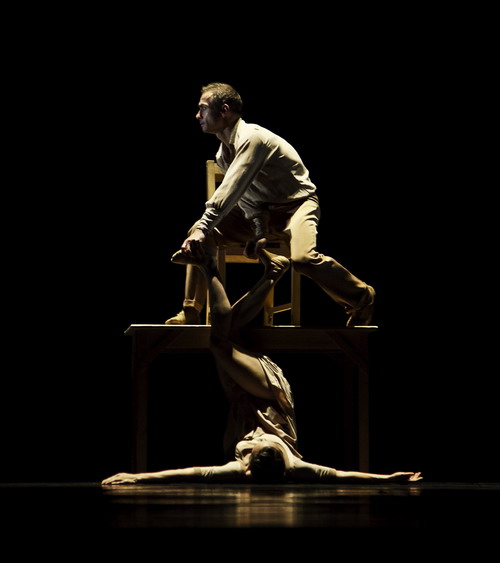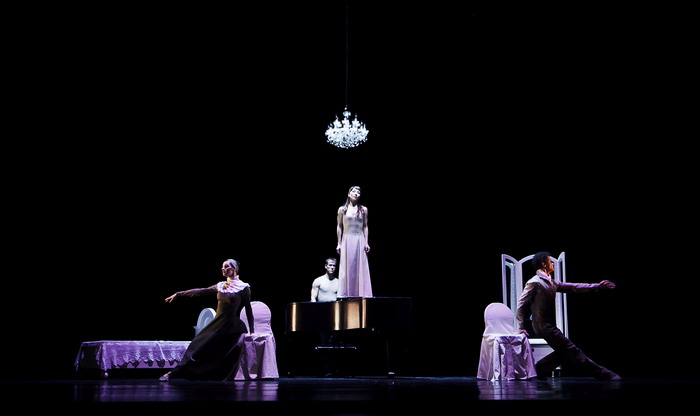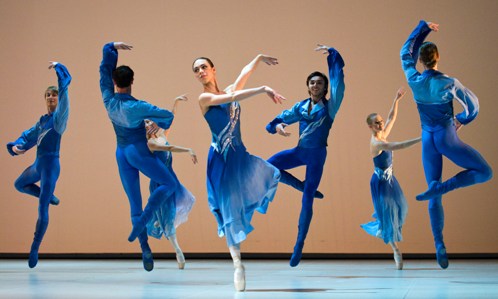 The end of theatre season 2011/2012 was somewhat extraordinary for the National Theatre ballet ensemble - from May 10th six full-length evening programmes, featuring the works by Petr Zuska were presented. The spectacular show ended the last day of June after nearly two dozen choreographies by this author had been performed.
Petr Zuska became the artistic director of the National Theatre Ballet in Prague in 2002. His appointment at that time aroused both enthusiasm and concerns what direction the leading ballet company in the country would take under his baton. His predecessor Vlastimil Harapes left the ensemble in a very good shape, emphasizing the necessity of high-standard renditions of the classical ballet repertoire and featuring his dancers in the works by the world's major choreographers, such as George Balanchine, Glen Tetley and Jiří Kylián.
Anyway, Petr Zuska joined the National Theatre Ballet not only as their artistic director, but also as a dancer and choreographer. His appointment to lead the company was to him also a unique opportunity to put his choreographic ambitions into effect with the country’
The end of theatre season 2011/2012 was somewhat extraordinary for the National Theatre ballet ensemble - from May 10th six full-length evening programmes, featuring the works by Petr Zuska were presented. The spectacular show ended the last day of June after nearly two dozen choreographies by this author had been performed.
Petr Zuska became the artistic director of the National Theatre Ballet in Prague in 2002. His appointment at that time aroused both enthusiasm and concerns what direction the leading ballet company in the country would take under his baton. His predecessor Vlastimil Harapes left the ensemble in a very good shape, emphasizing the necessity of high-standard renditions of the classical ballet repertoire and featuring his dancers in the works by the world's major choreographers, such as George Balanchine, Glen Tetley and Jiří Kylián.
Anyway, Petr Zuska joined the National Theatre Ballet not only as their artistic director, but also as a dancer and choreographer. His appointment to lead the company was to him also a unique opportunity to put his choreographic ambitions into effect with the country’s leading
and most numerous ballet ensemble. Meanwhile it was also essential not to neglect the long-standing tradition of this institution in keeping the masterpieces of the classical ballet repertoire alive. And the new artistic director has embarked on a demanding journey right from the very beginning – not all the proceedings have been easy, nor has he avoided some mistakes along the way, however, Petr Zuska has been the head of the National Theatre Ballet in Prague for ten years now, which is certainly an opportunity to evaluate the period. He chose to commemorate this anniversary by reintroducing his choreographies of the past ten years in a newly brought together full-length evening bills, centered around particular genre, themes or music. One could see excellent pieces combined with mediocre, or even below-average ones – for instance A Little Extreme, A Little Touch of the Last Extreme or
La sacre du printemps in my opinion do not belong among the highlights of Zuska’s creative output, whereas
Solo for three, featured on another evening, is undoubtedly a first-class production. It seems that Zuska simply chose to present his work of those ten years as an artistic director through thick and thin. Other ballets by major choreographers, featured at the National Theatre in that era were mentioned in a publication commemorating this event, but were not performed as a part of Gala X.
It is for sure that Zuska soon established himself as a prolific choreographer – after all, in those six full-length evening bills a total of eighteen pieces of his were performed, still far from the complete list of his choreographic creation. He did not miss the opportunity to demonstrate his strong personal affection towards his works either, attending all the evenings to present his choreographies to the public and showing his remarkable rhetorical gift, too. Come to that, it should be recognized that Zuska has certainly something to be proud of at least, just the fact that he survived the initial pressure and doubts and was able to establish a new course towards greater genre flexibility of his company is worth admiration. In addition to
John Cranko's Onegin, it was during his tenure as the head of the ensemble that pieces such as
Carmen by
Mats Ek, Kylián’s master
piece Petite mort, The Nutcracker and Romeo and Juliet by
Vàmos and Jean-Christopher Maillot’s extravagant
Cinderella entered its repertoire.
Classical ballet repertoire has been mostly featured in new arrangements that sometimes failed to replace the original concept and steps with equally valuable material (except for August Bournonville's original version of La Sylphide). But let us go back to the gala evenings.
These opened with Gala with the young, featuring choreographies that Zuska staged with the students of the Prague Dance Conservatory and Bohemia Ballet ensemble, followed by an evening bill of rather playful, relaxed and slightly absurd pieces stitched together under an apt title
Crazy stuff. Of course, Zuska’s
minifestival could not ommit Solo for three that was premiered at the National Theatre in 2007, a piece in which the author’s choreography added both impressiveness and a new dimension to
the songs of Jacques Brel, Vladimir Vysotsky and Karel Kryl.
One extra premiere
Among the pieces featured during the festival was a Czech premiere of Death and the Maiden, originally staged for Les Ballets de Monte Carlo in 2011. A choreography for six dancers tells a story of a dying young girl, who before her death recalls important moments in her life. Many in the audience, on the other hand, probably recall the eponymous composition by Franz Schubert. However, Zuska used just a part of it, rest of the music comes from various pieces by Leoš Janáček (alas, names of particular pieces are not mentioned in the programme brochure).
 Death – Viktor Konvalinka – is sitting at the piano, the girl – Edita Raušerová – is leaning against the instrument and the game of life and death begins. The structure of girl's reminiscences is built up clearly and with undiluted outline. The closer the girl gets to eternity, the more material things she leaves behind. Thus we see individual properties, referring to the turn of the 19th and the 20th century, disappear from the stage one by one. In her thoughts she recalls her parents, sister, a friend of her and her beloved. Anyway, Death is merciless and in the end the girl lies down into the grand piano.
This piece was preceded by Ways 03 and the duet Les Bras de Mer. In those two choreographies Zuska employs a specific shaping of movement, inspired by Jiří Kylián – bent arms, soft slides, touches and the interaction between the dancers, all of which refers to the work of the famous Czech choreographer. However, Zuska is far from being a mere eclecticist, he develops variations in a distinctive way; supported by delicate lighting the movement ornaments create magical images. Compared to Death and the Maiden, dance material in Ways 03 is shaped in a far more refined way and in an obvious unison with the music by Arvo Pärt. At the beginning dancers
Death – Viktor Konvalinka – is sitting at the piano, the girl – Edita Raušerová – is leaning against the instrument and the game of life and death begins. The structure of girl's reminiscences is built up clearly and with undiluted outline. The closer the girl gets to eternity, the more material things she leaves behind. Thus we see individual properties, referring to the turn of the 19th and the 20th century, disappear from the stage one by one. In her thoughts she recalls her parents, sister, a friend of her and her beloved. Anyway, Death is merciless and in the end the girl lies down into the grand piano.
This piece was preceded by Ways 03 and the duet Les Bras de Mer. In those two choreographies Zuska employs a specific shaping of movement, inspired by Jiří Kylián – bent arms, soft slides, touches and the interaction between the dancers, all of which refers to the work of the famous Czech choreographer. However, Zuska is far from being a mere eclecticist, he develops variations in a distinctive way; supported by delicate lighting the movement ornaments create magical images. Compared to Death and the Maiden, dance material in Ways 03 is shaped in a far more refined way and in an obvious unison with the music by Arvo Pärt. At the beginning dancers swerve from the line and hand covering their mouths slowly opens, motion synchronization is intertwined with the canonically built sequences. The black horizon at the beginning of the production moves up and suddenly we see only shadows of the dancers against the lit background. The choreography walks hand in hand with the minimalist music, to which Zuska adds another quality and makes it visible through movement.
Tribute to great tones
Compositions by major authors, such as a symphony by Gustav Mahler and excerpts from the scores of Antonín Dvořák, Bohuslav Martinů and Igor Stravinsky were played as a part of another triple bill.
 Mahler's Symphony in D Major inspired Petr Zuska to create a purely neoclassical dance composition that is clearly inferior in the compexity of structure to the music itself.
Since the premiere in Brno in 2004, the piece DMJ 1953-1977 has lost nothing of its appeal and continues to attract attention with its stage design, volatility of mood and subtlety of experiences that Zuska imprinted in this work of his.
La sacre du printemps from 2010 focuses more on the external form and falls short of delivering the spontaneity and drama of Stravinsky's score.
Touches of folklore
The audiences also had an opportunity to enjoy the poetics of Zuska’
Mahler's Symphony in D Major inspired Petr Zuska to create a purely neoclassical dance composition that is clearly inferior in the compexity of structure to the music itself.
Since the premiere in Brno in 2004, the piece DMJ 1953-1977 has lost nothing of its appeal and continues to attract attention with its stage design, volatility of mood and subtlety of experiences that Zuska imprinted in this work of his.
La sacre du printemps from 2010 focuses more on the external form and falls short of delivering the spontaneity and drama of Stravinsky's score.
Touches of folklore
The audiences also had an opportunity to enjoy the poetics of Zuska’s
inspiration by folklore hand in hand with the live performances of bands Hradišťan, Vyšívanka and Čechomor, which somehow added a unique authenticity to the whole evening bill. It is apparent that there is an intrinsic inner connection between the author and folk music themes, he captivates the poetic harmony of music and lyrics with obvious ease. His musicality is impeccable, and although his movement vocabulary in these choreographies (Oh, love, The Lyrical and Among the mountains) does not develop in any sighificant way, one cannot deny the fact that it is songs that inspires and nourishes Zuska’s
imagination the most.
Ensemble à la Zuska
During his tenure as the artistic director of the National Theatre Ballet, Petr Zuska has trained dancers who excellently interpret his choreographies – Nikola Márová, Tereza Podařilová, Zuzana Susová, Alexandre Katsapov and Viktor Konvalinka stand out the most among them. With Zuska’s appointment a great deal of contemporary dance vocabulary has been vigorously implemented in the company's repertoire. To that he added at the beginning a significant number of his own productions, however, his works have become less frequent since then. Even so, in the course of his ten-year tenure the dancers have been able to take in and get used to his style of work with a maximum focus and passion. This is certainly a significant asset, on the other hand, one cannot ignore the fact that the quality of the classical repertoire has not remained unscathed either, the most obvious manifestation being a considerable physiognomic diversity of the company, which does not suite the corps de ballet scenes at all. Classical ballets have been presented in vast majority in modified versions, which often do not attain the quality standards of the original choreographies. The recently featured Sleeping Beauty clearly demonstrated the lack of sophistication in academic style and form, not speaking of the missing refinement and accuracy of dance technique, which I consider essential aspects of the National Theatre Ballet.
The Petr Zuska Gala X show demonstrated the diversity of Zuska’s creative output
(he also danced in some pieces) as a choreographer, who is not a narrator of big dramatic stories. Instead, he focuses on the inner world, which may be greater than the one that surrounds us. He perceives and portrays this "inner landscape" with great passion. His choreographies feature a number of unforgettable experiences that do not slip off one’s mind that easily. After all, this is what really matters, isn't it ...
Petr Zuska Gala X
10th, 12th May 2012, Gala with the young: Rose, Déjà vu, Way out, Bolero.
17th, 18th, 19th May 2012, Crazy stuff: A Little Extreme, A Little Touch of the Last Extreme, Maria's Dream
26th, 27th, 28th May 2012, Brel-Vysotsky-Kryl/Solo for three
7th, 8th, 9th June 2012, Moves and stops: Ways 03, Les Bras de Mer, Death and the Maiden
20th, 22nd, 24th June 2012, A tribute to great tones: Symphony no. 1 in D major, D.M.J. 1953-1977, La sacre du printemps 28th, 29th, 30th June 2012, Touches of folklore: Oh, love, The Lyrical and Among the mountains
Photo: Michal Hančovský (2), Roman Sejkot (1)
Translation by: Tomáš Valníček






